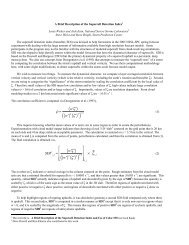Moisture Flux Convergence - Storm Prediction Center - NOAA
Moisture Flux Convergence - Storm Prediction Center - NOAA
Moisture Flux Convergence - Storm Prediction Center - NOAA
You also want an ePaper? Increase the reach of your titles
YUMPU automatically turns print PDFs into web optimized ePapers that Google loves.
component in the Kuo convective parameterization<br />
scheme developed in the 1960s, and, (3) severe local<br />
storm prediction beginning in 1970 as a direct result of<br />
(2). A more detailed treatment of the history of each of<br />
these areas is included in the following subsections.<br />
3.1 Calculations of precipitation in midlatitude<br />
cyclones<br />
Equation (3) can be solved for P–E, divided by the<br />
acceleration due to gravity g, and vertically integrated<br />
over the depth of the atmosphere from the surface p=p s<br />
to p=0 (Väisänen 1961; Palmén and Holopainen 1962),<br />
yielding<br />
1 ps<br />
∂q<br />
1 ps<br />
1 ps<br />
P − E = – ∫ dp – ∫ Vh<br />
⋅∇qdp<br />
– ∫ q∇<br />
⋅ V dp<br />
, (6)<br />
h<br />
g<br />
0<br />
∂t<br />
g<br />
0<br />
g<br />
0<br />
where the overbar represents a vertical integrated<br />
quantity. If one assumes that evaporation E is small in<br />
areas of intense precipitation and saturation, and that<br />
local changes in water vapor content are primarily those<br />
owing to advection in synoptic-scale systems (such that<br />
the first two terms on the right-hand side are in balance,<br />
see references above), then<br />
1 p s<br />
P ≈ – ∫ q ∇ ⋅ V h dp . (7)<br />
g 0<br />
Thus, the precipitation amount is proportional to the<br />
vertically integrated product of specific humidity and<br />
mass convergence through the depth of the<br />
atmosphere.<br />
The earliest synoptic application of (7) was from<br />
moisture budgets to estimate the large-scale<br />
precipitation in mid latitude cyclones using rawinsonde<br />
observations (Spar 1953; Bradbury 1957; Väisänen<br />
1961; Palmén and Holopainen 1962; Fankhauser 1965).<br />
However, advances in numerical weather prediction<br />
almost certainly resulted in the phasing out of these<br />
attempts beginning in the 1960s, although the concept<br />
was theoretically sound (but also quite laborious). The<br />
case studies referenced above over the United States<br />
and the United Kingdom showed that precipitation<br />
calculated from (7) reproduced well the observed spatial<br />
pattern of precipitation and the maximum precipitation<br />
amount associated with mid latitude cyclones.<br />
3.2 The Kuo Convective Parameterization Scheme<br />
Kuo (1965, 1974) wished to quantify the latent heat<br />
release during condensation in tropical cumulonimbus,<br />
the main source of energy in tropical cyclones. He<br />
surmised that quantification of the water vapor budget<br />
might reveal the magnitude of the vertical motion and<br />
latent heat release indirectly. He derived the vertically<br />
integrated condensation minus evaporation C – E as<br />
C − E = ( 1 − b ) gM t , (8)<br />
where b represents the storage of moisture and M t is<br />
termed the moisture accession:<br />
M<br />
t<br />
1<br />
⎤<br />
⎢⎣<br />
⎡ p s<br />
= – ∫ ∇ ⋅ ( q V +<br />
h ) dp F qs<br />
. (9)<br />
g 0<br />
⎥⎦<br />
<strong>Moisture</strong> accession is the sum of a vertically integrated<br />
MFC and F qs, the vertical molecular flux of water vapor<br />
from the surface. Kuo (1965) assumed that all the<br />
moisture accession goes into making clouds (i.e. b=0), a<br />
good assumption where tropical cumulus form in<br />
regions of deep conditional instability and large-scale<br />
surface convergence. Kuo (1974) found that b was<br />
much smaller than 1 in most situations and could be<br />
neglected in (9), leading to a direct relationship between<br />
the moisture accession and the condensation.<br />
Consequently, he argued that cumulus convection in the<br />
Tropics would be driven by the large-scale vertically<br />
integrated MFC.<br />
It is important to note that the Kuo scheme was<br />
developed initially for tropical cyclone simulations,<br />
where the important question is “how much” latent heat<br />
will be released, not “will” latent heat be released. In<br />
contrast, the latter is often of central concern to<br />
convective forecasters in mid-latitudes, particularly in<br />
thermodynamic environments possessing an elevated<br />
mixed-layer (Carlson et al. 1983) and some degree of<br />
convective inhibition (CIN) through most (if not all) of the<br />
diurnal cycle. More formally, the Kuo formulation<br />
assumes convection processes moisture at the rate<br />
supplied by the environment (i.e. statistical equilibrium<br />
exists, Type I convection (Emanuel 1994)). Conversely,<br />
the sudden release of a finite, and typically large,<br />
amount of CAPE that has been built over time is a<br />
binary episode (“triggered” or Type II convection<br />
(Emanuel 1994)) in which the timing, and even the<br />
occurrence of the convection itself, remains a difficult<br />
and important forecast problem. This dilemma holds<br />
true for both forecasters and numerical simulations, as<br />
was alluded to in the introduction. These imperfections<br />
in applicability of MFC endured by forecasters help to<br />
explain “false-alarm” events in which well-defined axes<br />
of MFC exist but capping inversions preclude deep<br />
convective development in otherwise favorable<br />
environments.<br />
3.3 Application of MFC to Mid Latitude Convection<br />
Hudson (1970, 1971) was the first to compute<br />
vertically integrated MFC and to compare it to the<br />
amount of moisture required for cloud development in<br />
the midlatitudes for nine severe-weather events,<br />
interpreting the ratio between these two quantities as<br />
the fraction of convective cloud cover. He computed<br />
vertically integrated MFC over a depth from the surface<br />
to 10 000 ft (3048 m) MSL because “most of the water<br />
vapor is in this layer and because loss of wind data<br />
becomes significant above this level” (Hudson 1971, p.<br />
759). Similarly, Kuo (1974) employed the top of his<br />
integration at 400 mb because of the perceived poor<br />
quality of the upper-air data above this level. Newman<br />
(1971), however, argued for using surface hourly<br />
observations to compute MFC because of their higher<br />
temporal and spatial resolution. As a result, he became<br />
the first to document the calculation of surface MFC.



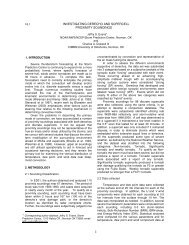
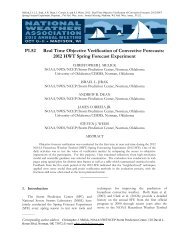
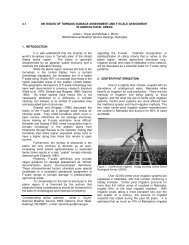
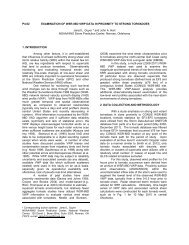
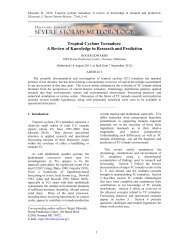


![NSWW_ROC_Overview.ppt [Read-Only] - Storm Prediction Center ...](https://img.yumpu.com/26478320/1/190x146/nsww-roc-overviewppt-read-only-storm-prediction-center-.jpg?quality=85)

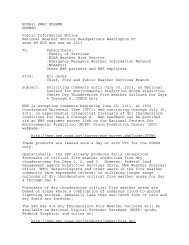
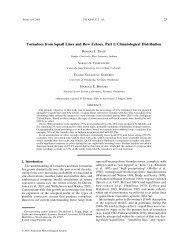

![NEW_PRODUCTS_imy.ppt [Read-Only] - Storm Prediction Center ...](https://img.yumpu.com/26478296/1/190x146/new-products-imyppt-read-only-storm-prediction-center-.jpg?quality=85)
